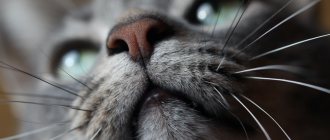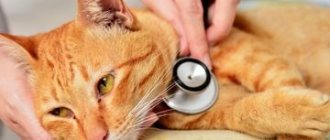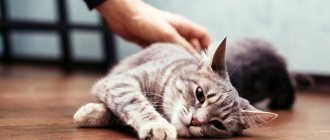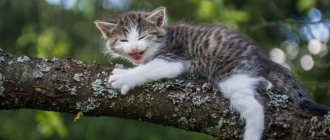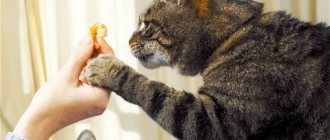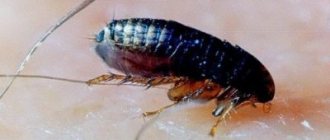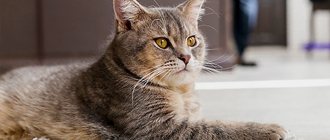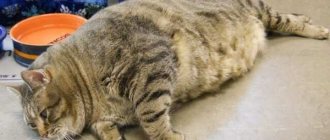11741Pavel
2
There are many myths about cats. There are no less misconceptions about their health. Even experienced owners do not always know what the cat’s condition and the temperature of individual parts of its body should normally be. It is believed that the nose should be wet and cool. And if a cat has a hot nose, it means he is sick and needs help. Unfortunately, the pet cannot tell us how it is feeling. A cat's nose can be an excellent indicator of changes in health.
What should a healthy cat's nose look like?
From the very first days of its life, a blind and deaf kitten relies only on its sense of smell: with its help, it finds its littermates, and its sense of smell helps to find the milky smell of its mother’s nipples. Throughout its life, the animal studies space through the nose, which means this organ, being one of the most active, can say a lot about the pet’s health.
Let's look at the structure of the cat's nose: it consists of two nasal entrances, separated by a cartilaginous septum, behind them begin the “ethmoid conchae” - a complex structure that allows cats to retain a certain smell in the corners of the shell and separate it from impurities for more accurate identification.
Structure of a cat's nose
Having passed through this complex structure, the odor molecules irritate the sensitive cells in the olfactory center of the nose, which helps the cat recognize the aroma and remember it.
IMPORTANT: a cat’s nose is 15 times more sensitive than a human’s and has about 80,000,000 receptors.
Smells that are familiar to humans can be very pungent for a cat: the smell of perfumes, spices, and citrus fruits will cause sneezing, and the animal will begin to rub and hide its nose.
Most often, animal owners observe the nose - a soft “button” on the animal’s face that everyone tries to touch. It is no coincidence that the nose is called a “mirror”: throughout your pet’s life, you can note what the cat “sees” with this organ.
Healthy nose
IMPORTANT: in a healthy state, the cat’s nose is slightly wet, not hotter than the animal’s body temperature. There are no pathogenic inclusions in the form of wounds, crusts, or obvious cloudy discharge.
Why does a cat's nose sometimes become a little wetter? The fact is that the nose secretes a special lubricant, the moisture of which protects the nasal passages from drying out. In addition, cats often deliberately lick their already wet nose.
In addition to its direct olfactory function, a cat’s nose warms and purifies the air it inhales; the skin of the nose is very sensitive and helps the animal determine the temperature of food, objects and surfaces without touching.
The color of the “mirror” of the nose matches the color of the fur on the muzzle; pigment spots may be present on it; the nose of an adult cat can also turn black with age. The black coloration of the nose makes it more difficult to identify a potential health problem; in this case, you can examine the mucous membranes of the mouth and eyelids. A light, almost white nose in cats most clearly demonstrates a possible illness, since blood vessels are clearly visible through it.
Black nose
Light, almost white nose
Pigmentation on the nose
What does a cat's too cold nose mean?
A cat's nose may be too cold when:
- hypothermia - the cat is placed in a blanket, a warm heating pad is applied, and a warm drink is offered;
- state of shock - shock is manifested by a sharp decrease in blood pressure, as well as: rapid and arrhythmic heartbeat;
- frequent shallow breathing, which slows down as the state of shock deepens;
- lethargy, turning into loss of consciousness;
- a decrease in body temperature below 37 o C;
- pale mucous membranes;
- cold nose, ears and paws;
- slow capillary refill rate (exceeds 2 seconds).
A state of shock is a direct threat to the life of a cat and requires its immediate delivery to the nearest veterinary hospital where there is a resuscitator. The cat needs to be wrapped in a blanket, placed on its side, the pelvic end raised to improve blood supply to the brain - and a great hurry to the clinic.
If a dry nose is combined with a subfebrile temperature, the animal should be monitored. It is not necessary to achieve a drop in temperature, because the symptom may be the animal’s reaction to overheating, stress, or the fight against an infectious agent. In most situations, a dry nose or slightly elevated temperature goes away on its own.
If a febrile temperature is registered, the cat's skin and fur are slightly moistened, cold objects are applied to the groin or neck, and veterinary help is called. It is impossible to reduce the temperature with medications intended for humans - the effect of medications on cats and people is not the same.
Kuleshov Evgeny Ivanovich; veterinarian, associate professor, candidate of agricultural sciences
https://localvet.ru/koshki/simptomy/suhoy-nos
If your cat has a high temperature (hyperthermia), do not immediately panic. An increase in the indicator can occur due to heat stroke in the hot season, or during pregnancy of the pet. Often, an increase in body temperature of several tenths of a degree occurs in animals during stressful situations, in kittens - during weaning from their mother, or during overeating. However, if the indicator is exceeded by one degree or more, you should not hesitate to visit a veterinary institution. A specialist will advise you on how to reduce the cat’s temperature after carrying out the necessary diagnostics and identifying the cause of hyperthermia in the animal. The owner’s task is to timely identify the pet’s illness. You should not give your cat antipyretic medications on your own. Many human fever medications are contraindicated for use in animals. In addition, by lowering the temperature without using specific treatment for infectious diseases, you can waste time and worsen the condition of a sick pet.
Lyubov Ilyina, veterinarian
zootvet.ru/kak-izmerit-temperaturu-u-koshki/
A dry and warm nose can often be found in healthy cats in a limited number of situations, and it can also be one of the symptoms of illness, including severe illness. Therefore, when assessing the likelihood that a cat may develop a disease, the general condition of the animal, the results of thermometry, as well as the appearance of certain symptoms of the disease are of great importance. A dry nose in a cat is not a specific symptom indicating any pathology; at the same time, a dry and warm nose is an easily accessible indicator indicating the occurrence of a water imbalance in the cat’s body caused by dehydration and fever. When the underlying disease is cured, the condition of the nose is normalized on its own and does not require separate measures.
Share with your friends!
A pet's nose does not always serve as an indicator of disease. Based only on the surface temperature of the organ of smell, it is impossible to determine whether a pet is sick.
A cat's nose is designed to perform many tasks and functions.
In terms of its functionality, the nose is a complex mechanism and performs many tasks assigned to it by nature. In simple terms, the structure of an organ can be described in a few sentences.
- It consists of the body itself, which includes two passages, the so-called nostrils, separated from each other by a fragile partition - cartilage.
- These passages pave the way into a depth consisting of several corners in which the cat, if necessary, retains the scent he needs, first getting rid of other scents in order to highlight the main scent.
- The stored aroma molecules irritate the receptors associated with the olfactory part of the brain and odor recognition occurs.
A healthy cat's nose is moist and not dry. But the absence of these signs is not yet a fact of illness.
Strong and pungent odors
Too strong odors can injure your pet's nose.
By the way, a cat, due to its predatory nature, has much more of these receptors than a human.
Therefore, strong and pungent odors can injure your pet’s overly sensitive sense of smell.
Naturally, a cat’s nose performs more than just an olfactory function. It is also an important element of the respiratory system mechanism
. Inhaling too humid, hot or cold air, the mucous membrane of this mechanism adapts it to the most comfortable temperature and normal functioning of the entire system.
Should I worry?
If you are convinced that everything is in order with the cat’s health, the animal’s nose does not need additional care. Health problems are excluded by clinical diagnosis in a veterinary clinic, regular care of the animal, good nutrition and routine vaccination, deworming, cleaning from fleas and other parasites.
IMPORTANT: if you find a warm, dry nose on a cat, leave the animal for a while and touch the nose again. If you find other alarming symptoms, consult a specialist!
How to treat a cat at home
Let's say that you were prescribed treatment and entrusted to cure the animal yourself.
What to do if the cat has a hot nose and is really sick and is completely in your care?
- It is best to swallow tablets in capsules completely together with the protective coating: pre-lubricate them with oil, place them on the middle of the tongue and push them down the throat.
- Try to prevent the cat from biting through the medicine and resisting it, otherwise the procedure will be very difficult to repeat. In a capsule, the tablet dissolves directly in the intestines and this is more effective than mixing its contents with food or drink, since you will not be able to control the cat’s desire to eat or drink all the contents.
Why do pets sometimes get sick, despite our care and careful care for them? Probably because all living things tend to lose their protective forces and weaken.
Don't ask unnecessary questions. Treat your wonderful cat correctly, and make sure that the disease does not recur.
Features of the animal's condition
In a normal state, the animal’s lifestyle does not change. Minor changes in the appearance of the nose can be caused by external factors and resolve on their own. In this case, the animal helps itself: it washes itself, licks and moisturizes its nose. The pet remains active, eats well, plays a lot and shows affection to its owner.
In the presence of pathology, the animal’s behavior changes
IMPORTANT: make sure that the animal always has fresh and clean water, and that the room maintains a comfortable temperature.
A cat has a dry and warm nose: when is this a sign of illness?
Sometimes a cat has a dry and warm nose - this is a harbinger of a serious illness. Sometimes the illness turns out to be very serious. The nose becomes dry in the following cases:
- Gastrointestinal disorders. A cat can be poisoned by stale, bad food, this can happen after taking antibiotics. In this case, the cat’s nose becomes dry, its body temperature increases, and the cat may be accompanied by vomiting, loose stools, and weakness. The pet may refuse food altogether.
- Infectious, viral, bacterial disease. In addition to the fact that your pet's nose may become dry, his body temperature may increase, he may be bothered by a fever, and have loose stools. The cat may sneeze, refuse food or water.
- Diseases caused by ticks . The cat often begins to scratch his ears and muzzle, shake his head, behave restlessly, and refuse to eat. In this case, as a rule, the animal’s skin becomes inflamed, thickens, the skin in the head area becomes bald, its temperature rises, and its nose becomes dry.
- Cold - the cat's ears become hot, his nose becomes dry and cool. Body temperature increases, the animal weakens.
Maybe due to workload
- Note that a dry spout almost always has the same temperature - minimum +39.5°C and maximum +40°C. What can cause hyperthermia? There can be quite a few reasons: the presence of cancer, failures in the functionality of certain organs.
- The nose may become dry if the cat has worms, which poison the animal's body. In addition, there are cases when a cat suddenly develops a fever, but he still feels healthy.
- To help you understand whether your cat is sick or completely healthy, check his nose for moisture. Be sure to pay attention to what temperature your pet’s nose is and what condition it is in. Is the cat bothered by vomiting, diarrhea, does the animal refuse to eat, does it have discharge from its eyes, nose, and so on. If your animal’s nose is constantly dry, or other alarming symptoms arise, then immediately take your pet to the veterinary clinic.
- If your pet's nose is even hot (you feel this at the first touch), and the animal itself looks weak, this is very serious. The kitten's temperature may rise significantly. Don't wait, take your pet to the doctor immediately.
Disease
A similar thing occurs in domestic animals during a viral infection. And such diseases, as a rule, can be dangerous and lead to death. To avoid this, you should do the following:
- Place the cat in a room that is well ventilated. Just make sure there are no drafts. The ideal room temperature in this case is +20°C.
- Give your pet plenty of water. You can add a little sugar to it.
- Call your veterinarian.
Kitten has a hot nose
A hot nose in kittens is most often a sign of their playfulness and increased activity. They run a lot, play, are very curious and try to quickly explore the world around them. A warm and dry nose in this case is not a cause for concern.
Increased activity can cause temporary dry nose in a kitten.
But if you notice that the kitten’s nose remains dry throughout the day, or purulent discharge appears, contact a specialist. Such signs may indicate the occurrence of rhinitis, as well as neoplasms in the nasal passages and sinuses.
Show increased attention to your baby: at an early age, foreign bodies may enter the nasal cavity.
The cat has a warm nose, what should I do?
A pet's warm nose may not always mean the onset of a disease.
Surface temperature of the nose is important for preliminary examination and suspicion of the presence of a problem, but there are many reasons when hyperthermia is not a symptom of the disease.
When you shouldn't worry
It is important to remember that hyperthermia of the olfactory organ without any accompanying symptoms may simply be a reaction of the cat’s dissatisfaction to certain circumstances.
Causes for concern
Reasons for concern should arise when there are alarming, previously unusual signs of animal behavior.
Lack of interest in food, water and lethargy of the pet can alert the owner.
But also the presence of symptoms indicating that the pet is experiencing discomfort:
- loss of interest in food and water;
- insatiable appetite or thirst;
- breathing problems - shortness of breath;
- body hyperthermia above 40 degrees;
- presence of signs of respiratory diseases – , ;
- there is pain in any area;
- signs of digestive system disorder - nausea, diarrhea;
- violation of the act of urination;
- discharge mixed with blood or pus;
- sloppy appearance – dull or unkempt fur;
- drowsiness, lethargy, weakness;
- the presence of blood or mucus in the urine or feces, change in the color of stool.
Such signs indicate the presence of pathology in the animal’s body, and you should immediately consult a doctor.
How to examine an animal yourself?
First, pay attention to the color of your nose and oral mucosa. Touch the paws and inspect them for redness.
IMPORTANT: if the nose is black, inspect the eyelids and the surface of the mucous membrane in the animal’s mouth.
This is what anemia looks like on the oral mucosa
– pallor of the mucous membrane occurs with hypothermia, the development of anemia, the initial stage of poisoning;
– yellow color of the mucous membrane indicates liver disease;
– bluish color of the mucous membrane may indicate a malfunction of the heart;
– redness is characterized by infections, inflammations, allergies, increased temperature and pressure.
Next, using a stopwatch, you can measure the cat's pulse from the inside of the thigh. Feel the pulsation and count the tremors for 15 seconds. Multiply the sum of calculations by 6, so you will determine the number of beats per minute.
An example of how to measure a cat's pulse at home
IMPORTANT: the animal’s normal pulse is no more than 140 beats per minute. The animal's pulse may change during the mating season.
How to warm a cat's paws
As written above, your task is to determine the base body temperature and if it is normal, but the cat’s paws are still cold, you need to try to warm them. First, evaluate how warm it is in the home and how the pet behaves:
- Does the cat walk on the floor or prefer to move on the top? The higher you go, the warmer the air.
Perhaps your pet is freezing?
- Perhaps the cat was moulting and the weather suddenly got colder - our pets are warmed by the undercoat, not the guard hair.
- Does your pet climb into your bed to sleep? If so, she is looking for additional heat sources
.
The best option is Insulated with a thick backing
. Recently, recommendations have appeared on forums about insulating houses with heat-insulating fabric. Yes, it doesn’t look very attractive, but you can’t lure cats out of their warm nests.
Note!
During sleep, the temperature and heat transfer of a cat’s body increases, therefore (if the house is cold) the pet may freeze in its sleep.
How to take your pet's temperature
Enlist the help of a person to whom the animal is friendly - this will make it easier to measure the cat’s body temperature. Be gentle, do not make sudden movements, lull and stroke the animal.
An electric thermometer will give the most accurate readings
IMPORTANT: the cat must have its own individual electric thermometer. Body temperature is measured through the anus of the animal and should not exceed the limit of 38-39 degrees.
Take a thermometer, disinfect it, treat it with Vaseline to soften the passage. Place the cat on a hard surface, you can calmly grab the animal with your hands and fix it. Carefully place the thermometer 2 cm into the anus. Calm and stroke the cat, hold the thermometer for the right time (the electric thermometer will notify you yourself).After manipulations, re-disinfect the thermometer and place it in the first aid kit.
Symptoms that require doctor's attention
Use caution and seek medical attention if you notice any serious changes in your cat's behavior:
– the animal has become lethargic, apathetic, refuses to eat;
– sleeps a lot, does not respond to calls to play, is indifferent to favorite treats and entertainment;
– the cat’s stool becomes more frequent or worse, and vomiting appears;
– increased salivation is observed;
– green nasal discharge and sneezing appeared;
– the animal reacts negatively to an attempt to touch it;
– body temperature is increased, paws and ears turn red and become very hot;
The presence of such symptoms is a reason to immediately visit a veterinary clinic.
Symptoms You Shouldn't Ignore
If your pet's behavior changes due to a hot nose, it is necessary to closely monitor its condition. If the clinical picture only intensifies, it is important to take the animal to a veterinary clinic .
The following signs may indicate the disease:
- apathy and lethargy;
- constant sneezing;
- characteristic discharge from the nostrils;
redness of the eyes;- aggressive behavior;
- increased irritability;
- being in a secluded place;
- deterioration of the condition of the coat (fades, clumps);
- the cat doesn't eat anything.
If there are problems with the digestive system, then when you touch the stomach, the cat will experience pain, which is manifested by increased anxiety.
Before seeking help from a specialist, you need to exclude exposure to factors such as temperature changes, stress, and the presence of allergens.
If your ears and nose are hot at the same time, this may indicate a general increase in body temperature.
The presence of discharge from the cat's nostrils often indicates the development of sinusitis or rhinitis.
What measures should be taken
Only a doctor can diagnose the presence of a dangerous pathology in combination with external signs.
IMPORTANT: if you notice an illness, you can measure the animal’s pulse and temperature - this is the permissible maximum of measures that you can take at home before the veterinarian arrives. Diagnostics and other medical procedures are carried out only by a specialist!
You can help your animal by eliminating external factors that can cause changes in the nose:
- Regulate the heating temperature of the room, and thoroughly dry the animal’s fur after water treatments. Make sure that the cat is in a warm and comfortable environment, this way you will prevent your pet from becoming hypothermic.
- If your pet spends time outside in hot weather, constantly replenish the supply of clean and fresh water, make sure that the cat has access to a cool place. The animal will feel dehydration and will help its body on its own.
IMPORTANT: with a sunburn, the skin on the nose turns red and becomes hot and painful. In this case, Panthenol gel will help you; you should apply it carefully, avoiding getting into the nostrils. Make sure that the animal does not have other alarming symptoms.
A red and sore nose may be a sign of sunburn
- Humidify the indoor air and regularly ventilate the room in which your pet is located.
- Protect your cat from any factors that cause fear or stress in the animal.
- After consulting a veterinarian, you can learn how to clear your pet’s nose of snot and dirt on your own - this way you will make your animal’s life easier. Nasal rinses are purchased at a veterinary pharmacy, and the first rinse is carried out under the supervision of a veterinarian.
- The position of a cat before giving birth requires special attention: the animal is susceptible to stress, pain and emotional outbursts. Monitor the cat's condition, provide care and, if necessary, call a doctor at home.
What are the signs that require contacting a veterinarian?
If the following symptoms are detected in a kitten, you should consult a veterinarian to identify the causes of your pet’s illness:
- malaise, lethargy, apathy; dry and hot nose; cold and pale nose; change in organ color (blue, yellowish, red, white).
The owner should know that a pale and cold organ in a kitten is a sign of:
- chronic illness; hypothermia; stress; low body temperature; poisoning; complete lack of appetite.
A white and warm nose is a sign of a disruption in the kitten’s circulatory system. The blue and hot organ talks about:
- heart failure; inflammation of the respiratory organs; oxygen starvation.
When a kitten has a hot and red organ, this is a sign:
- infectious disease; rhinitis; mechanical damage.
If a kitten has a hot, dry nose and warm ears, then this is not necessarily a sign of illness, because heat exchange has not yet been established in babies, and their body temperature is higher than that of an adult pet. This may be due to the work of the body and its protection from hypothermia.
Advice for caring owners
When communicating with our beloved pet, we don’t need words: we feel their love and affection, observe how playfully and carefree they show their habits, and admire their grace. As creatures of the wild, domestic cats live and experience this world through their baser instincts.
A happy pet creates the world around him through the care of his owner
You can get much closer and learn to understand your pet's signals and behavior by learning basic information about the structure of their amazing organisms. Regular care and attention to your pet will make you a rare guest in the veterinarian's office.


